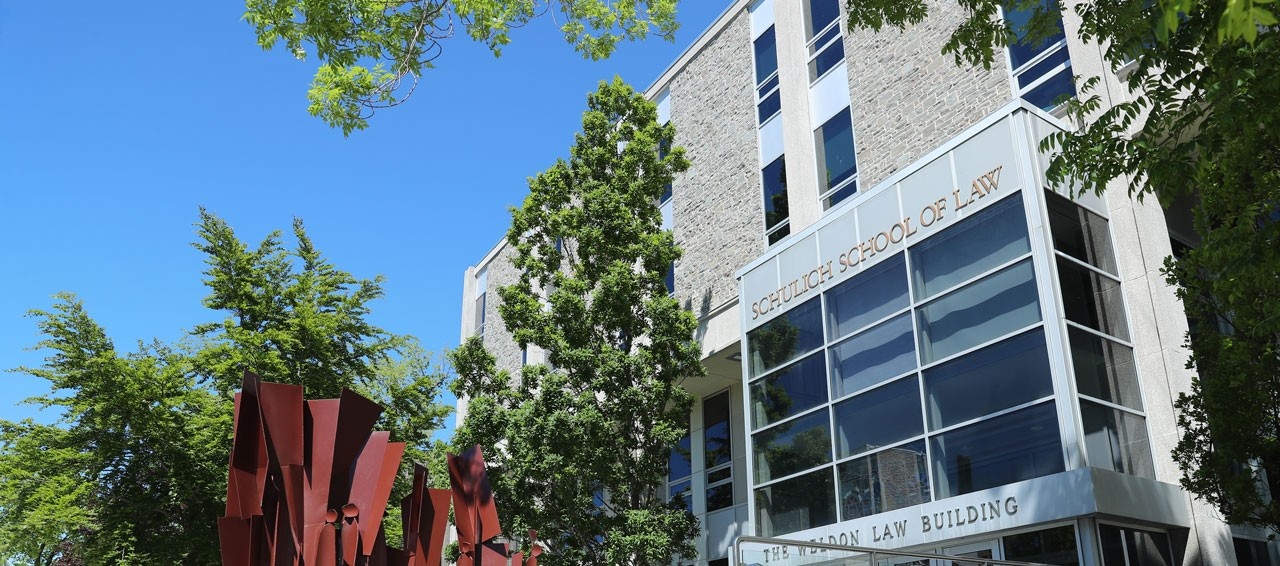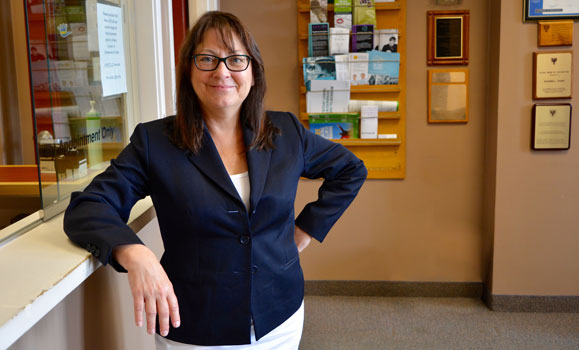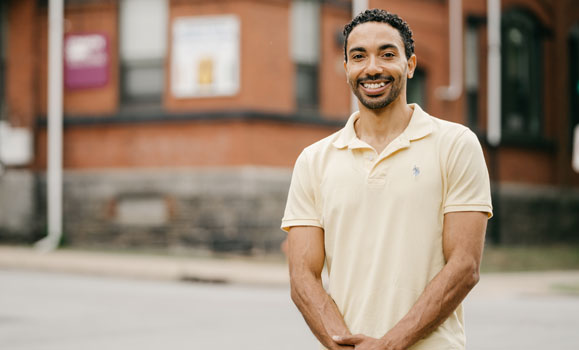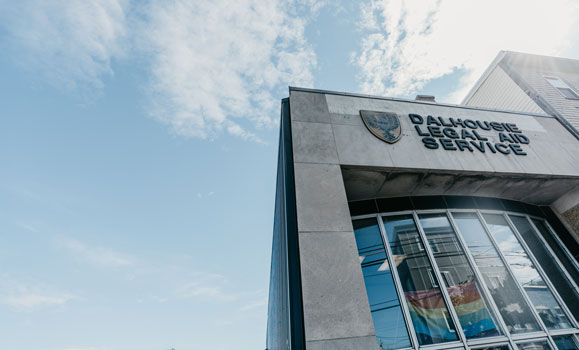News
» Go to news mainCelebrating 50 Years of Dalhousie Legal Aid Service
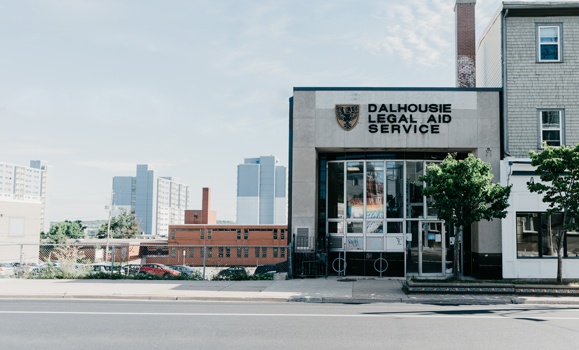
The work it takes to create a better, more equitable world is never complete. Dalhousie Legal Aid Service (DLAS) is celebrating 50 years of that dedication and hard work. Work that is just as important, just as relevant today as it was 50 years ago. Perhaps, some might argue, even more so.
If there is a theme that runs through the kinds of stories that are told about DLAS, it is this: Every person who has spent time there as a client, as a staff member, or as a student, believes that there is always something—and someone—else to keep fighting for.
But to say that DLAS is only about the fight is far from the whole story. DLAS balances optimism with realism. Tenacity with acceptance. All in service to making progress that is tangible and real, whether that serves a single person or thousands of people fighting an unjust system.
After educating and shaping over 2000 students, this is a moment to reflect and celebrate in the history of DLAS. It is also a moment to look to the future, and the next 50 years of change that its staff, students, clients, and community will create in the lives of people here in Nova Scotia and across the country.
This is a story that’s far from over. But in its telling, we can recognize what’s already been achieved and strengthen the resolve of those who will shape the stories to come.
The early days of the Clinic
In the summer of 1970, the Halifax Neighbourhood Centre alongside students from the law school at pilipiliÂţ» were spending their days—and likely evenings—inside, away from summer’s freedoms, doing something new.
They were creating what would become the Dalhousie Legal Aid Service (the Clinic, as it’s often called) because they felt and heard what the community in the North End of Halifax needed. The community was crying out for access to justice for those experiencing barriers to legal services. And Dalhousie’s law students believed they could do something about it.Ěý
“The real movers and shakers behind the establishment of the Clinic were students from the law school,” says Dick Evans, a former Clinic director, who was instrumental in shaping the vision and structure of DLAS for its future. When the Clinic was founded, by and for its community, it became the first university-based clinical law program in Canada. From its inception, and thanks to the dedication of its many champions, the Clinic’s mission has always been clear:
- To provide legal aid services for persons who otherwise would not be able to obtain legal advice or assistance.
- To conduct research, provide information, make recommendations and engage in programs relating to legal aid and law reform in the province of Nova Scotia.
- To provide an educational experience in the solution of legal problems for students enrolled in the Faculty of Law of pilipiliÂţ» who participate in the work of the Service (the Clinic).
The early days of the Clinic were undeniably different from today. For instance, Evans remembers that just before he joined the Clinic, there was not an existing director in place and the students were rather short on supervision. “When I arrived in June of 1975, Sarah Mackenzie, a newly called lawyer and recent hire was holding down the fort, along with just five summer students.” Like every new organization, the early DLAS team had to not just think outside the box, but sometimes do things in a less-than-traditional fashion.
Rollie Thompson (’78) can attest to this. Thompson is currently a member of the Board of Trustees. He’s acted as both the Clinic board’s chair and vice-chair, and as a student in 1977-78, he sat on the board as a student member. And, most importantly, he was the Clinic’s executive director from 1982-1985 and reprised this role from 1991-94 alongside Evans.
“Even when I wasn’t actively at the Clinic, I was still involved,” Thompson says. “I’d take cases, consult with lawyers, and stay in touch with clients.” So to say he is intrinsically woven into the fabric of the Clinic may be an understatement.
He remembers his first case at the Clinic—a two-day custody trial. “I had no idea what I was doing,” Thompson laughs. “But the learning experience for students has improved dramatically over the years and so has the standard of practice. The students are the ones who make it possible for DLAS to handle its incredible caseload.”
Donna Franey (’86) the Executive Director of DLAS for the past 25 years, remembers the organized chaos of the Clinic’s early days as well. “One of the students was involved in a family case and the judge ended up ordering the client’s belongings to be delivered to DLAS,” remembers Franey. “Sometimes the Clinic is the only way to make something work for someone who needs help. It can be a fly-by-the-seat-of-your-pants experience.”
Ěý
Shaping law students
Within this unique atmosphere, the principles that were shaping the Clinic’s culture, were clear and true: to provide access to justice, enact important law reform, and to educate and develop young lawyers.
This early clarity brought with it remarkable drive and dedication to the community from everyone at the Clinic. In 1976, Evans and Doug Kane, a community development worker, helped the Clinic evolve from an advisory board to include nine community representatives. An important change ensuring that the perspective of the people the Clinic serves remains at the heart of its mission, its work, and the students it teaches.
Lori McCurdy (’94) says that what’s special about the Clinic is the ability for students to create change. “It goes beyond the academic,” she says. “We were exposed to various experiences of communities we might not otherwise have been aware of and learned that we could do something to contribute to changing those experiences - improving those experiences.”
“One thing that’s remained consistent is the drive from students and staff to help clients,” Thompson says. “Motivation has never been an issue. Everyone wants to do right by their clients.”
Franey agrees. “The students work so hard and form such a bond with the clients. It’s human nature for the more established team to worry about new students coming in—that they won’t treat the clients as well as the past students did. But that’s never the case. Students always see that people are people, no matter where or who they are. And every person deserves to be treated with the same dignity.”
The Clinic’s impact on its students can’t be understated. Not only because of the practical experience it provides, but because of the values and ideals it imparts.
And powerful values stick.
Today, the true picture of those who study law is significantly more diverse and representative of the society in which we live. The people studying law come with more varied and unique backgrounds, and may come with an understanding and experience that aligns with clients at the Clinic too.
This wasn’t always the case. Over the years the Clinic opened many young eyes to the reality and truth of Nova Scotian communities, and the injustice, poverty, and inequality that still exist. “Many law students that come from backgrounds of privilege are suddenly immersed in poverty law,” says Nova Scotia Supreme Court Justice John Bodurtha (’95). “We are privileged to be learning the law and it teaches students the opportunities a law degree presents to advance the causes of marginalized communities.”
It is clear that an experience at the Clinic teaches so much more than the law. It clarifies what is worth fighting for. It imparts courage and confidence. It highlights the inevitability of loss. And it demonstrates, every day, the power when people come together.
The one and the manyĚý
The stories that have shaped the Clinic are often singular. A story of one client, one case, one relationship. They are a memory or moment.
But the truth is that these individual stories represent so much more, and one of the Clinic’s many strengths has been its ability to be the bridge between the one and the many. For a small staff, the Clinic has brought pilipiliÂţ»ful cases to the Supreme Court of Canada on three separate occasions.
“It really is the little engine that could,” says Justice Bodurtha. “Some of the cases the Clinic has been involved in are remarkable and it deserves to be recognized and supported for these achievements.”
Access to justiceĚý
Rocky Jones (’92) is a legend not only in Nova Scotia’s legal system, but in the social justice landscape as well. His legacy is exemplified in his work with Rodney Small, who was tried in Youth Court before Judge Corrine Sparks (’79). His case centered around an interaction between Small and a police officer.
Though both he and Jones didn’t know it early on, Small’s case would end up representing so much more in Canadian law, connecting dots between racial bias, policing, justice, civil rights, judicial impartiality and more. While Judge Sparks—notably the first Black judge in Nova Scotia—had found Small not guilty, the Crown’s reaction to the ruling led Jones and Small all the way to the Supreme Court of Canada. This experience fundamentally changed Small’s life, and ultimately, set legal precedents when it came to racial bias in policing across the country.
“Rocky was the real deal, a lawyer who was a social advocate too,” Small remembers. “We had a real relationship, and it was bumpy sometimes because I was rough around the edges. But he had so much positive energy, so when I wanted to back away from the case, Rocky was strong for me.”
Raised in Uniacke Square, Rodney is now the Director of ONE North End and part of Common Good Solutions, an organization in Atlantic Canada developing strategies to build equitable policies to improve the lives of poor and marginalized communities.
“Back then, I was ready to leave Nova Scotia,” Small says. “I was going down a dark path. But when I read the decision about my case on the front page of the newspaper, I knew it was my time, and that I needed to pull myself in a new direction.”
Today, as a leader in his community, Small also focuses on sharing the history of his neighbourhood and bringing people together to create change. “Dalhousie Legal Aid is a pillar in this community. It gives space for real dialogue and is truly representative of the people it serves,” he says. “I was lucky to have a lawyer in my life who understood my situation. Who knew my community and was in my community.”
Shawna Paris-Hoyte (’94), Q.C. and 25-year veteran of DLAS as a staff lawyer, acknowledges just how meaningful this case was. “It has had an enormous impact,” she says. “It gave the Supreme Court of Canada voice to the issue of race and bias. And twenty-three years later, our team continues this work today, giving voice to things like racial injustice in street checks and other social issues.”
This is just one story—one of many that represent the change and impact that DLAS has had. What can’t be denied: The Clinic’s ongoing legacy of ensuring the legal rights of underrepresented communities both in Nova Scotia and in Canadian law.
Law reform
Institutional power is slow and difficult to impact. It’s hard to criticize, dismantle, or move bureaucracy forward.
But pilipiliÂţ» Legal Aid Service has done it. Many times over.
Today, for instance, Nova Scotia has some of the best rules and regulations in the country governing credit, collections and disconnection by Nova Scotia Power, thanks to the tireless work of Thompson and former DLAS caseworker Jeanne Fay, among many others.
“There was a fundamental truth in the argument that we fought to have recognized,” says Thompson. “If the Utility and Review Board was going to give permission to raise rates, then regulations had to evolve too. There needs to be more protection for low-income communities, and eventually we came out with a set of rules and regulations that could continue to be improved.”
Franey says that the Clinic works to prioritize more of these kinds of cases, digging down to systemic problems to create change. “When you see something time and time again, our team looks for the root of the issue,” says Franey. “Whether it’s an adult protection matter, ensuring that the government puts the welfare of the person ahead of their own interests, or a human rights inquiry about whether disabled people are being unnecessarily institutionalized, removed from their communities and losing their autonomy, we are doing transformative work.”
The teamwork that imbues everything DLAS does is also something Franey emphasizes. “We have community legal workers, lawyers, and students out there working with people all the time,” she says. “So often the community comes to us and tells us where we need to focus attention so that we not only create meaningful law reform, but also contribute to tangible change in the community we serve.”
Community impactĚý
Even when addressing broad change at the institutional level, the issues DLAS tackles are often ones of basic human survival, issues connected to poverty, health, shelter, human rights, discrimination and so many more.
Paris-Hoyte understands that fact on a fundamental level. “We are, in many ways, the last stop for people whose everyday existence is threatened,” she says. “Our connection to the Dalhousie School of Social Work means we can work collaboratively to address bigger social issues—we help fuse law and social work together. And the gaps between these two things have the greatest impact on marginalized communities.”
Perhaps the best example of this fusion is the Clinic’s contribution to Bryony House. In 1978, the Clinic helped create the first transition house in Nova Scotia providing emergency services for women affected by intimate partner abuse. And early in Bryony House’s history, two members of the DLAS team left the Clinic to work with Bryony House full-time.
“The Clinic began outreach sessions there once a month with residents,” says Franey. “Many of these women had never had to find housing, or try to get income assistance, or deal with criminal law or peace bonds. Our team was learning along with the Transition House Association how best to protect people and what services they needed.”
Paris-Hoyte believes you need these kinds of embedded relationships with the community to make a real difference. “A lot of legal aid Clinics hire social workers,” she says. “But DLAS has long-standing connections and a very diverse team when it comes to legal and life experience. And when your community legal workers have a background in social work, it adds a special lens to everything we work on.”
Senator Kim Pate (LLB ’84), who has spent four decades advocating on behalf of marginalized and victimized Canadians, agrees. “The importance of having a social worker attached to the Clinic helped me see that we weren’t just looking at court cases, but we were looking at important public policy areas.” Put simply, the Clinic builds bridges.
The Clinic’s resilience and tenacity also ensures that things get done.
A lasting legacyĚý
Whether it’s a scared client, a young student, or an overextended lawyer, those who enter the Clinic may enter feeling alone.
That feeling doesn’t last long.
The importance of the work, the dedication of the team, and the sense of making a difference all work together to create bonds that stand the test of time. Whether a lawyer has just started their law career or has been practicing for decades, the impact of the Clinic never leaves.
Katie Brady (JD ’19) says that her Clinic experience helped her reconnect with why she wanted to study law in the first place. “I wanted to help people,” she says. “I lost that clarity in law school and it was only after my legal aid experience that I regained that focus that allowed me to find the people in the stories I’d hear in class.”
The connections between classroom theory and the real world also became clear to Dinyar Marzban (LLB ’81), now a Q.C. and family law attorney in Vancouver, during his time at the Clinic. “One of my Clinic lawyers was Sarah Mackenzie,” he remembers. “She was always calm, always smiling, but really tough too. Once she sat with me for hours going through an affidavit, correcting tense, grammar, clarity of thought. I probably learned 75 percent of my drafting skills in that one session with her, from having an experienced lawyer go through a real affidavit with me.”
Ellen Williams (JD ’20) shares this perspective. “You don’t get the human component of law from textbooks,” she says. “Being able to communicate with someone in times of stress is a learned art, and you need to be their rock. The hands-on experience at the Clinic got me ready for the real world.”
“It was fun too,” says McCurdy. “You were with like-minded people doing meaningful work, applying legal principles—sometimes in creative ways—and you always felt supported.”
The richness of human experience is woven throughout the history of DLAS. Every person who has experienced it, used it, learned from it, brings some of its optimism and hope with them on their own journey.
A beacon of tomorrowĚý
The cases and people who will come next to Dalhousie Legal Aid Service are unknowable. But while the specifics might be cloudy, the principles shaping the Clinic’s future remain steadfast.
“For fifty years, DLAS has been providing an essential service to our community, making legal information and advice available to people who would not otherwise have that access. It has also given thousands of law students a great opportunity to apply their learning, acquire valuable lawyering skills, and gain an understanding of the challenges – and not only legal challenges - that are faced by so many people,” says Schulich School of Law Dean Camille Cameron. “As we look to the next 50 years, we are committed to continuing to support and champion the Clinic so that it can carry on this work, work that can make a big difference in the lives of clients, students, and the community.”
The Clinic will teach. It will open eyes, reveal truth, build character, and push students and clients to be and do things they didn’t think they could. It will be generous with its knowledge, to individuals and to its community, sharing what it learns and bringing ideas and people together.
It will open the avenues to justice for those who have no other way and be a voice for those who need one. It will illuminate the patterns of injustice that should demand our attention and the legal changes we can make to improve our society and the lives of every citizen.
It will continue to serve the community that has nurtured it for the last 50 years. Amid all the wins and the losses, all the frustrations and the steps forward, DLAS will unite those striving for justice in all its forms. And, ultimately, it is a very special place in our community, representing the people of Nova Scotia who are fighting for a better world.
Recent News
- Professor Emeritus Wayne MacKay ft in "Legal columnist Wayne MacKay looks at tough‑on‑crime campaign promises"
- Professor Emeritus Wayne MacKay ft in "A closer look at "tough on crime""
- Associate Professor Naiomi Metallic ft in "Opinion: Indigenous issues absent in federal election"
- Dalhousie Legal Aid Service ft in "Dalhousie Legal Aid urges vigilance as stricter deadlines for tenants are put in place"
- Professor Matthew Herder ft in "Canadians could lose vital safety information amid deep cuts to the U.S. FDA, experts warn"
- Professor Kim Brooks ft in "Opinion: Trump’s freeze on national research funding an in for Canada"
- Associate Professor Michael Karanicolas ft in "Lawyers say Advocates' Society needs reform after org cancels event amid keynote speaker backlash"
- Professor Emeritus Wayne MacKay ft in "Nova Scotia moving to modernize traffic safety protocols"
